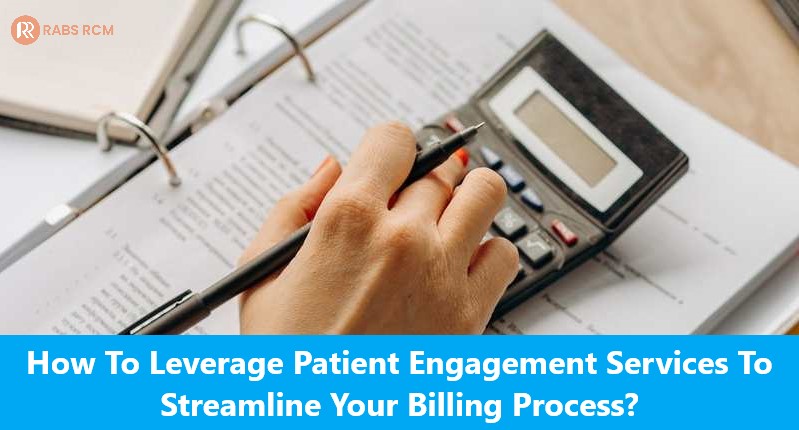
How To Leverage Patient Engagement Services To Streamline Your Billing Process?
Are you seeking a game-changing solution to streamline your revenue cycle management? Look no further! Rabs RCM medical billing services are designed to empower your practice and propel it to new heights.
Managing patient engagement and streamlining billing processes are critical components of a successful healthcare practice. As the healthcare industry evolves, providing top-notch patient experiences and optimizing billing efficiency have become paramount. This article explores how healthcare providers can leverage patient engagement services to streamline their billing process, ensuring improved patient satisfaction and financial outcomes
Understanding Patient Engagement Services
Patient engagement services encompass a range of tools and strategies aimed at actively involving patients in their healthcare journey. These services empower patients by enabling access to their medical information, promoting communication with healthcare providers, and encouraging involvement in decision-making processes. Effective patient engagement can lead to increased adherence to treatment plans and better health outcomes.
The Benefits of Streamlining the Billing Process
Streamlining the billing process offers numerous advantages for both healthcare providers and patients. Simplifying billing procedures reduces administrative burdens, minimizes billing errors, and accelerates the revenue cycle. For patients, transparent and efficient billing enhances satisfaction and builds trust in the healthcare provider.
Selecting the Right Patient Engagement Service Provider
Choosing the right patient engagement service provider is a crucial step in optimizing the billing process. Look for a service that integrates seamlessly with your existing electronic health record (EHR) system, provides user-friendly interfaces, and offers secure communication channels. Consider their track record, customer reviews, and data security protocols before making a decision.
Integrating Patient Engagement Solutions
To ensure a successful implementation, healthcare providers must integrate patient engagement solutions throughout the organization. Train staff to effectively use these tools and encourage patients to enroll in the system. A holistic approach to integration guarantees that both parties can make the most of these services.
Read More: The Benefits of Outsourcing Credentialing & Enrollment Services
Streamlining Billing Process: Step-by-Step Guide
Step 1: Assess Your Current Billing System
Begin by evaluating your current billing system’s strengths and weaknesses. Identify pain points and areas that require improvement to streamline the process effectively.
Step 2: Define Objectives for Streamlining
Set clear objectives for streamlining the billing process. Define key performance indicators (KPIs) to measure success and progress.
Step 3: Implement Patient-Friendly Payment Options
Offer various patient-friendly payment options such as online payment gateways, mobile payments, and flexible payment plans. Simplifying payment methods enhances patient convenience.
Step 4: Automate Billing and Payment Processes
Invest in billing software that automates repetitive tasks, such as invoicing, payment reminders, and claims processing. Automation reduces errors and accelerates the billing cycle.
Step 5: Enhance Communication Channels
Establish effective communication channels to keep patients informed about their bills, upcoming appointments, and payment options. Personalized communication improves patient engagement.
Step 6: Implement Electronic Health Records (EHR)
Electronic Health Records (EHR) ensure seamless access to patient information, reduce paperwork, and enhance data accuracy. Integrated EHR systems improve billing accuracy and efficiency.
Step 7: Monitor and Evaluate the System Regularly
Regularly monitor the streamlined billing process, gather feedback from staff and patients, and make necessary adjustments to optimize performance continually.
6. Overcoming Challenges in Patient Engagement and Billing
Despite the numerous benefits, healthcare providers may face challenges during the implementation of patient engagement services and streamlined billing. Common obstacles include data privacy concerns, resistance to change, and initial investment costs. Addressing these challenges proactively is vital for the long-term success of the initiative.
7. Ensuring Data Security and Compliance
With the digitization of healthcare data, ensuring data security and compliance is paramount. Implement robust cybersecurity measures, adhere to industry regulations, and educate staff on data protection protocols.
8. The Future of Patient Engagement Services
The future of patient engagement services looks promising. Advancements in technology, such as artificial intelligence and telemedicine, will further enhance patient experiences. Embracing these innovations will strengthen patient engagement and optimize the billing process.
Conclusion
Patient engagement services play a pivotal role in streamlining the billing process, benefiting both healthcare providers and patients. By implementing effective patient engagement strategies and optimizing billing procedures, healthcare practices can improve financial outcomes and patient satisfaction. Embracing innovation and adapting to the changing landscape of healthcare will ensure a prosperous future for both patients and providers.
Read More: Maximizing Revenue with Payment Posting Services: A Guide for Medical Billing Professionals

